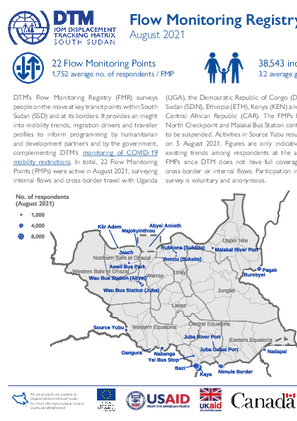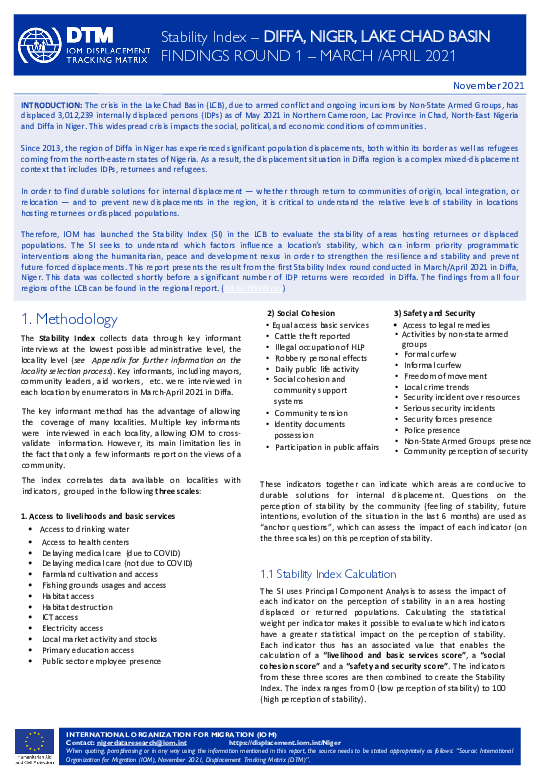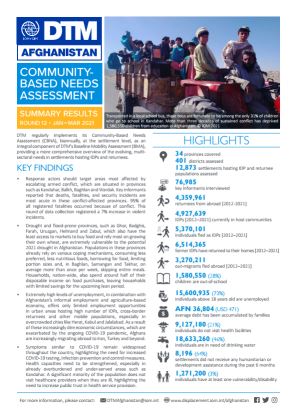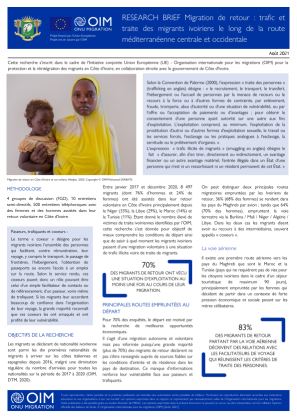-
Countries
-
Data and Analysis
-
Special Focus
-
Crisis Responses
Return migration

Contact
DTM South Sudan, SouthSudanDTM@iom.int
Language
English
Location
South Sudan
Period Covered
Aug 01 2021
Aug 31 2021
Activity
- Flow Monitoring
DTM’s Flow Monitoring Registry (FMR) surveys people on the move at key transit points within South Sudan (SSD) and at its borders. It provides an insight into mobility trends, migration drivers and traveller profiles to inform programming by humanitarian and development partners and by the government, complementing DTM’s monitoring of COVID-19 mobility restrictions. In total, 22 Flow Monitoring Points (FMPs) were active in August 2021, surveying internal flows and cross-border travel with Uganda (UGA), the Democratic Republic of Congo (DRC), Sudan (SDN), Ethiopia (ETH), Kenya (KEN) and the Central African Republic (CAR). The FMPs Renk North Checkpoint and Malakal Bus Station continue to be suspended. Activities in Source Yubu resumed on 5 August 2021. Figures are only indicative of existing trends among respondents at the active FMPs since DTM does not have full coverage of cross-border or internal flows. Participation in the survey is voluntary and anonymous.
Please click here to access a summary dataset.

Contact
DTM South Sudan, SouthSudanDTM@iom.int
Language
English
Location
South Sudan
Period Covered
Jul 01 2021
Jul 31 2021
Activity
- Flow Monitoring
DTM’s Flow Monitoring Registry (FMR) surveys people on the move at key transit points within South Sudan (SSD) and at its borders. It provides an insight into mobility trends, migration drivers and traveller profiles to inform programming by humanitarian and development partners and by the government, complementing DTM’s monitoring of COVID-19 mobility restrictions. In total, 21 Flow Monitoring Points (FMPs) were active in July 2021, surveying internal flows and cross-border travel with Uganda (UGA), the Democratic Republic of Congo (DRC), Sudan (SDN), Ethiopia (ETH), and Kenya (KEN)4. The FMP Renk North Checkpoint continues to be suspended. Since mid-June, data collection activities in Source Yubu are on hold due to insecurity, while activities at Malakal Bus Station are halted due to inaccessibility caused by flooding. Figures are only indicative of existing trends among respondents at the active FMPs since DTM does not have full coverage of cross-border or internal flows. Participation in the survey is voluntary and anonymous.
Please click here to access a summary dataset.

Contact
DTM Niger, NigerDataResearch@iom.int
Language
English
Location
Niger
Period Covered
Mar 01 2021
Apr 30 2021
Activity
- Other
- Mobility Tracking
Since 2013, the region of Diffa in Niger has experienced significant population displacements, both within its border as well as refugees coming from the north-eastern states of Nigeria. As a result, the displacement situation in Diffa region is a complex mixed-displacement context that includes IDPs, returnees and refugees.
In order to find durable solutions for internal displacement — whether through return to communities of origin, local integration, or relocation — and to prevent new displacements in the region, it is critical to understand the relative levels of stability in locations hosting returnees or displaced populations.
Therefore, IOM has launched the Stability Index (SI) in the LCB to evaluate the stability of areas hosting returnees or displaced populations. The SI seeks to understand which factors influence a location's stability, which can inform priority programmatic interventions along the humanitarian, peace and development nexus in order to strengthen the resilience and stability and prevent future forced displacements. This report presents the result from the first Stability Index round conducted in March/April 2021 in Diffa, Niger.

Contact
DTM Nigeria, AllUsersInDTMNigeria@iom.int
Language
English
Location
Nigeria
Period Covered
Jun 21 2021
Jul 27 2021
Activity
- Mobility Tracking
- Baseline Assessment
In response to the need for accurate and up-to-date information on human mobility and forced displacement in North East Nigeria, IOM activated its Displacement Tracking Matrix (DTM) to support the Government and the humanitarian community with
multi-layered data on the numbers, trends, status, locations and needs of populations affected by the on-going conflict in North East Nigeria. Round 38 of assessment was conducted from 21 June to 27 July 2021.
This dashboard provides key figures on the numbers, demographic profile, location and accommodation arrangement of returnees. A total of 1,918,063 returnees were recorded in the DTM Round 38 assessment. including 1,763,395 Former IDP Returnees and 154,668 Returnees from abroad. This represents a significant increase of 164,579 individuals or 9 per cent compared to Round 37.

Contact
DTM Iraq, IraqDTM@iom.int
Language
English
Location
Iraq
Period Covered
May 01 2021
Jul 31 2021
Activity
- Mobility Tracking
- Baseline Assessment
Data collection for Round 122 took place between 1 May and 31 July 2021. As of 31 July 2021, DTM identified 4,884,612 returnees (814,102 households), dispersed across 8 governorates, 38 districts, and 2,162 locations in Iraq. A total of 17,562 new returnees were recorded between May and July 2021

Contact
DTMAfghanistan@iom.int
Language
English
Location
Afghanistan
Period Covered
Jan 01 2021
Mar 31 2021
Activity
- Mobility Tracking
- Site Assessment
In January through March 2021, DTM implemented the Community-Based Needs Assessment (CBNA) at the settlement level, as an integral component of DTM's Baseline Mobility Assessment (BMA), providing a comprehensive overview of the evolving, multi-sectoral needs in settlements hosting IDPs and returnees.

Contact
DTMAfghanistan@iom.int
Language
English
Location
Afghanistan
Period Covered
Jan 01 2021
Mar 31 2021
Activity
- Mobility Tracking
- Baseline Assessment
In Afghanistan, DTM employs the Baseline Mobility Assessment tool, designed to track mobility, determine the population sizes, locations and geographic distribution of forcibly displaced, return and migrant populations, reasons for displacement, places of origin, and times of displacement, as well as basic demographics, vulnerabilities and priority needs. Data is collected at the settlement level, through community focus group discussions with key informants and direct observations.
As of 31 March 2021, 34 provinces, 401 districts and 12,882 settlements have been assessed, including interviews with 77,019 key informants. Between 2012 and March 2021, 4,359,961 returnees and 4,927,639 IDPs currently living in host communities were identified.

Contact
IOM South Sudan DTM ISSDTM@iom.int
Language
English
Location
South Sudan
Period Covered
Nov 01 2020
Dec 31 2020
Activity
- Mobility Tracking
- Baseline Assessment
This atlas contains a summary of findings form the tenth round of Mobility Tracking conducted across South Sudan through key-informant based assessment at payam and location level between November and December 2020. Mobility Tracking quantifies the presence of internally displaced persons (IDPs) and returnees in South Sudan in displacement sites and host communities. IOM DTM mapped a total of 1,710,966 IDPs (6% previously displaced abroad) and 1,734,329 returnees (34% from abroad) in 3,038 locations across South Sudan.

Contact
mschramm@iom.int
Language
French
Location
Côte d’Ivoire
Period Covered
Apr 01 2021
Apr 30 2021
Activity
- Other
- Return Intention
Les migrants se déclarant de nationalité ivoiriennesont parmi les dix premières nationalités demigrants à arriver sur les côtes italiennes etespagnoles depuis 2016, malgré une diminutionrégulière du nombre d'arrivées pour toutes lesnationalités sur la période de 2017 à 2020 (OIM,DTM, 2020).
Entre janvier 2017 et décembre 2020, 8 497migrants (dont 76% d’hommes et 24% defemmes) ont été assistés dans leur retourvolontaire en Côte d’Ivoire principalement depuisle Niger (33%), la Libye (29%), le Maroc (14%) etla Tunisie (11%). Etant donné le nombre élevé devictimes de traite ivoiriennes identifiées par l’OIM,cette recherche s’est donnée pour objectif demieux comprendre les conditions de départ ainsique de saisir à quel moment les migrants ivoirienspassent d’une migration volontaire à une situationde trafic illicite voire de traite de migrants.

Contact
mschramm@iom.int
Language
French
Location
Côte d’Ivoire
Period Covered
Aug 31 2021
Sep 07 2021
Activity
- Other
Cette étude consacrée au trafic et à la traite des migrants ivoiriens de retour le long de la route méditerranéenne centrale et occidentale a été rendue possible grâce aux données collectées et analysées dans le cadre de l’Initiative Conjointe Union Européenne (UE) – Organisation internationale pour les migrations (OIM) pour la protection et la réintégration des migrants en Côte d’Ivoire, mise en oeuvre en étroite collaboration avec le Gouvernement de Côte d’Ivoire
Pagination
- Previous page
- Page 17
- Next page
